![]()
![]()
![]()
Use LEFT and RIGHT arrow keys to navigate between flashcards;
Use UP and DOWN arrow keys to flip the card;
H to show hint;
A reads text to speech;
67 Cards in this Set
- Front
- Back
|
Molecules that are with both hydrophobic and hydrophilic. Name 2 examples. |
Amphipathic. Cholesterol, glycolipids |
|
|
What is the structure of a phospholipid? |
Polar hydrophilic head and nonpolar hydrophobic tail. |
|
|
When the hydrocarbon tail has no double bonds. |
Saturated |
|
|
What is the name of the spherical vesicle that phospholids form? Forms in the ECF of the bilayer. |
Liposome |
|
|
The molecule that fits in the spaces between phospholipids? What are the 2 characteristics? |
Cholesterol -less permeable -less flexible |
|
|
What are the 3 types of lipids? |
Phospholipids, cholesterol, glycolipid |
|
|
What defines and effects the bilayer composition? |
Hydrocarbon tail defines fluidity - shorter tail = higher fluidity - unsaturated hydrocarbon tail increases fluidity |
|
|
Describe where lipid synthesis occurs and the enzyme required. |
Takes place in the ER - uses fatty acids to synthesize phospholipids SCRAMBLASE transfers random phospholipids between monolayers |
|
|
Where do glycolipids obtain their sugar group? |
Golgi |
|
|
What are the 4 types of membrane proteins? |
Transport, Anchors, Receptors, Enzymes |
|
|
Proteins that are amphipathic, hydrophobic region lie in the bilayer. Their hydrophilic regions are exposed to each side of the membrane. |
Transmembrane |
|
|
Membrane protein are located almost entirely in the cytosol; have an amphipathic a helix exposed on the surface of the protein |
Monolayer-associated |
|
|
Describe the structure of transmembrane proteins. |
Contain a-helices that goes through the membrane bilayer. - They contain hydrophobic side chains - peptide bonds are polar - Single pass (cross membrane once) -Multi pass (multiple a helices crossing the membrane form channels) |
|
|
Describe flippase. |
Remove specific phospholipids from the side of the bilayer facing the exterior space and FLIP them into the monolayer that faces the ctyosol |
|
|
Describe the transmembrane protein B sheets and B barrels |
- B sheet is rolled into a B barrel - in barrel = hydrophiliic, out barrel = hydrophobic - amino acid side chains in barrel - forms aqueous channel |
|
|
The sugar coating formed by all of the carbohydrate on the glycroproteins, proteoglycansm and glycolipids located on the outside of the the plasma membrane. |
Glycocalyx |
|
|
What are the 2 types of molecules that can be transported through simple diffusion? (7 examples gonches) |
Small nonpolar molecules - O2, CO2, N2, steroid hormones Small uncharged polar molecules - H2O, ethanol, glycerol |
|
|
What are the 2 types of molecules transported using facilitated transport? |
Larger uncharged polar molecules Ions |
|
|
What is the ion concentration of the cell membrane in terms of K+, Na+, and Cl-. |
K+ ~ high inside Na+ ~ high outside C- ~ high outside |
|
|
What are the characteristics of transporters? |
~ SPECIFIC molecule or protein must fit into its binding site |
|
|
What are the characteristics of channels? |
Molecules transfer based on their SIZE and CHARGE |
|
|
Describe the 2 methods of passive transport. |
~ molecules go through channels ~ passive transporter |
|
|
Describe the 2 characteristics of active transport. |
~ movement against concentration gradient ~ requires pumps (active transporters) |
|
|
Movement of water down its concentration gradient |
Osmosis |
|
|
Total concentration of solute inside the cell |
Osmolarity |
|
|
What are the 2 components of the electrochemical gradient? |
~force from the concentration gradient of the solute ~force from the membrane potential |
|
|
Describe the function of an aquaporin. |
A specialized channel that facilitates the flow water across the plasma membrane faster then regular simple diffusion. |
|
|
Describe the Sodium Potassium Pump. |
Na+ transport is couple by K+ ~Ouabain is an inhibitor (inhibits K+ binding to pump) Creates high Na+ concentration in the extracellular space |
|

Describe coupled transport. |
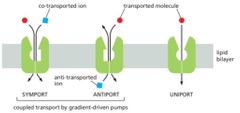
Symport - transfer solutes in the same direction Antiport - transfer solutes in opposite direction |
|
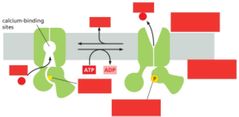
Describe Ca2+ pump in the sarcoplasmic recticulum. |
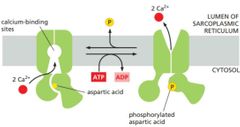
Muscle cell is stimulated => influx of Ca2+ from sarcoplasmic recticulum into cytosol. |
|
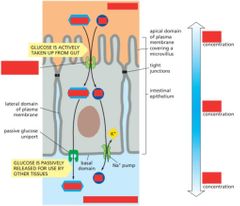
Describe and label glucose transport in the gut. |
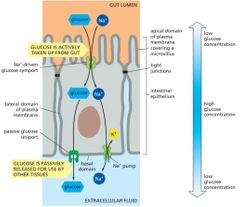
- symport transport |
|
|
What is cell respiration? |
Sugars are broken down and oxidized to produce CO2 and water Energy is captured in high energy chemical bonds |
|
|
What is energy in an organism? |
Responsible for growth and development of cell |
|
|
What is catabolism? |
The breakdown of molecules into smaller subunits - releases free energy |
|
|
What is anabolism? |
Smaller molecules build up into larger molecule - free energy added |
|
|
What is the general overview of the oxidation of food and the net products? |
Glycolysis (in cytosol) => Citric Acid Cycle (inner mito mem(inm)) => Oxidative phosphorylation (inm) Net results: Food + O2 => ATP + NADH + CO2 + H2O |
|
|
The ATP bond that stores lots of energy. |
Phosphoanhydride bond |
|
|
Glycolysis: location, total formula |
Location: Cytosol Formula: Glucose + 2 ATP => 2 Pyruvate + 4 ATP + 2 NADH Note: net atp is 2 |
|
|
What is the function and role of kinase in glycolysis? |
Function: adds phosphate group to molecule Gylcolysis: transfers phosphate group FROM ATP to a substrate in steps 1 & 3; transfers TO ADP to form ATP in steps 7 & 10 |
|
|
What is the function and role of isomerase in glycolysis? |
Function: rearranges bonds within a molecule Glycolysis: Steps 2 & 5 prepare molecules for chemical alterations coming |
|
|
What is the function and role of dehydrogenase in glycolysis? |
Function: Oxidizes a molecule by removing a hydrogen atom plus an electron Glycolysis: Step 6, the enzyme generates NADH |
|
|
What is the function and role of mutase in glycolysis? |
Function: Shifts chemical group from one position to another within a molecule Glycolysis: Step 8 - phosphate group is moved to transfer it to ATP from ADP in step 10 |
|
|
What are the enzyme types involved in each of the 10 steps of glycolysis? (KIK AID KMEK) |
1) Kinase 2) Isomerase 3) Kinase 4) Adolase (gylcolytic enzyme) 5) Isomerase 6) Dehydrogenase 7) Kinase 8) Mutase 9) Enolase 10) Kinase |
|
|
What are the starting molecules, products and the location of fermentation in a muscle cell and in yeast? |
Starting Molecules: Pyruvate Products: muscle ~ lactate & NAD+; yeast ~ ethanol, CO2 & NAD+ Location: Cytosol |
|
|
When does fermentation occur? |
breaks down sugar in absence of oxygen |
|
|
What is the starting molecules, products, and location of the process of pyruvate debcarboxylation? |
Starting molecule: Pyruvate Products: CO2, NADH, Acetyl CoA Location: mitochondria |
|
|
What are the starting molecules, products, and location of the process of fatty acid oxidation? |
Starting molecule: Fatty acyl CoA Products: FADH2, NADH, Acetyl CoA Location: Mitochondria |
|
|
What is the starting molecule, products, and location of the citric acid cycle? |
Starting Molecule: Acetyl CoA Products: FADH2, NADH, GTP, CO2 Location: Mitochondria |
|
|
What are the enzymes involved in the 8 steps of the citric acid cycle? |
(LIDD KD HD) 1) Ligase (joins molecules) 2) Isomerase 3) Dehydrogenase 4) Dehydrogenase 5) Kinase 6) Dehydrogenase 7) Hydrolase 8) Dehydrogenase |
|
|
What is FADH2? |
A carrier of high energy electron and hydrogen |
|
|
What is GTP? |
Produced in the citric acid cycle. Transfers one phosphate group to ADP. |
|
|
What are the 2 anabolic reactions and the 4 intermediate products? |
Glycolysis: pyruvate Citric acid cycle: Citrate, oxaloacetate, and succinyl CoA |
|
|
Which 2 organelles have double membranes, which organelle is largest? |
Nucleus & mitochondria ER is largest |
|
|
What are nuclear pores? |
- Channels in the nuclear membrane - enable communication with the cytosol - protein binds to receptor => goes through nuclear pore |
|
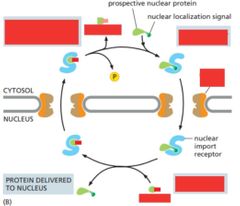
Label the GTP hydrolysis cycle that drives nuclear transport. |

|
|
|
What are the 3 major transport mechanisms? |
Nuclear pores, protein translocators, transport vesicles |
|

Label the mitochondrial protein import diagram. What happens to proteins before entering mitochondria & chloroplast? |

Proteins unfold |
|
|
How do peroxisome proteins transport? |
Sequence of 3 a.a. signal transport to perox. - receptor proteins in cytosol recognize transport sequence - protein translocator - no conformational change Vesicular transport |
|
|
Describe protein transport to the ER. |
- most proteins destined for the golgi, lysosome, and endosome enter ER 1st - ER signal sequence is 8 a.a. or more long - signal recognition particle (SRP) binds to signal and ribosome - SRP receptor on the ER membrane |
|
|
What are the 2 types of transmembrane protein? |
Single pass transmembrane protein Double pass transmembrane protein |
|
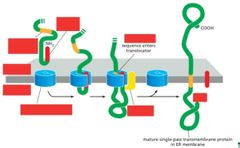
Describe single-pass transmembrane proteins. |

~ has a N-terminal (red) that initiates transfer (cleaved off leaving the protein anchored to membrane) ~ Stop-transfer sequence (orange) that discharges polypeptide when it enters protein translocator |
|

Describe the double-pass transmembrane protein. |
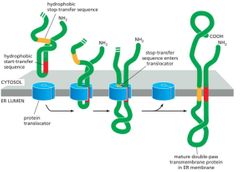
~ has a start-transfer sequence (red, helps anchor protein to membrane, is recognize by SRP receptor) ~ has a stop-transfer sequence (orange, translocator discharges the sequences when it's reached) ~ neither sequence is cleaved off |
|
|
What is a locatization signal? |
Proteins that have nuclear localization signals are allowed entry into the nucleus |
|

What are the molecules involved in coated vesicle formation and what do they do? |
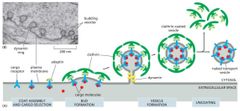
Clathrin coat - helps form vesicle Dynamin - binds on neck, puts pressure on it and pinches it off |
|
|
What breaks down Ran? |
Ran=protein so a PROTEASE |
|
|
Contains hydrolytic enzymes which break down extracellular material and worn out organelles and is acidic because of proton pumps. |
Lysosomes |
|
|
Describe how LDL (low-density lipoproteins) enters the cell through receptor mediated endocytosis. |
1) LDL binds to LDL receptors on the cell surface & enters cell by clathrin-coated proteins. 2) vesicles lose their coating and fuse with endosome 3) In acidic endosome, LDL & receptor dissociate 4) LDL to lysosome and degraded to release cholesterol 5) LDL receptors return to membrane via vesicles |

